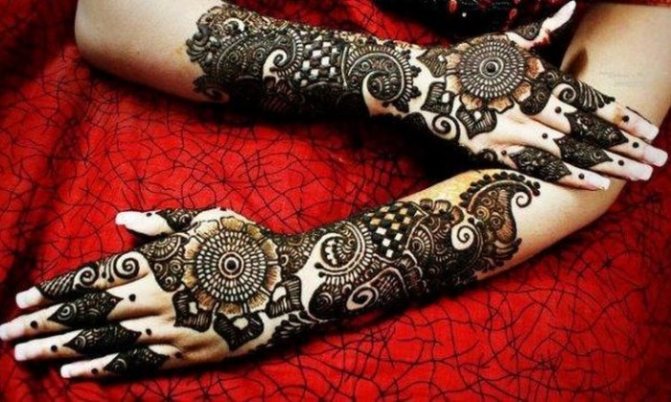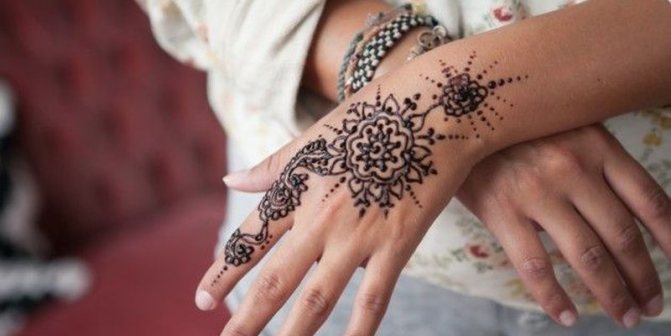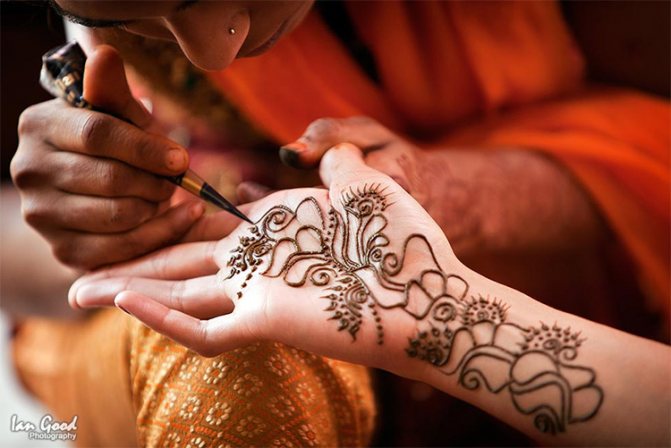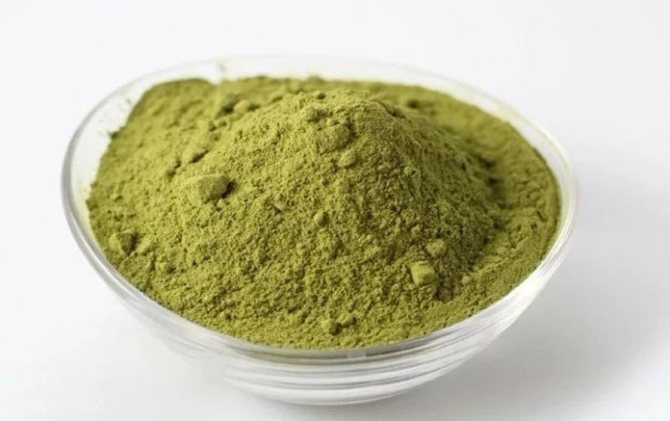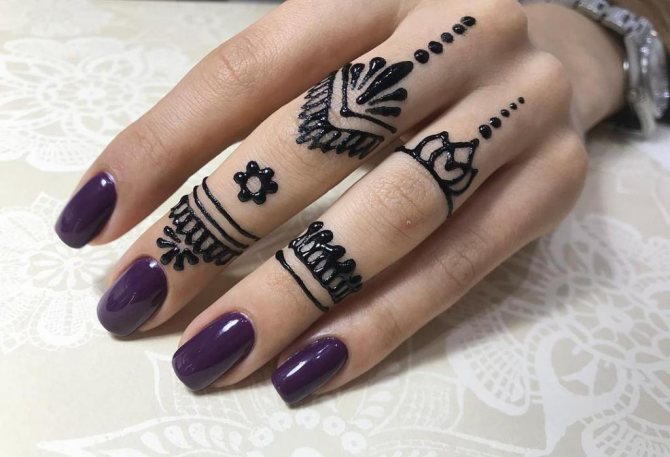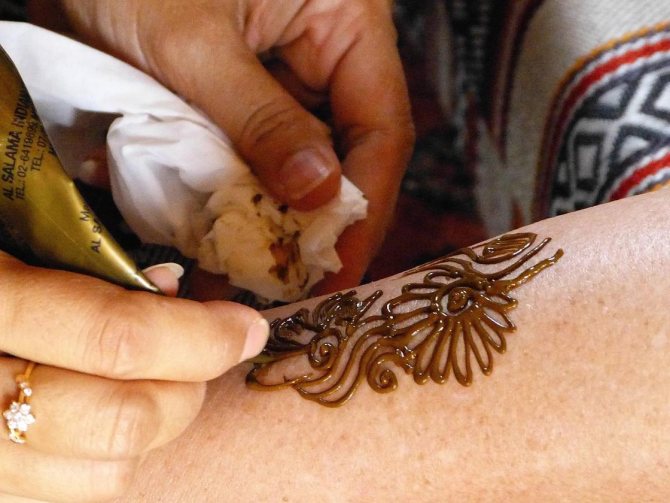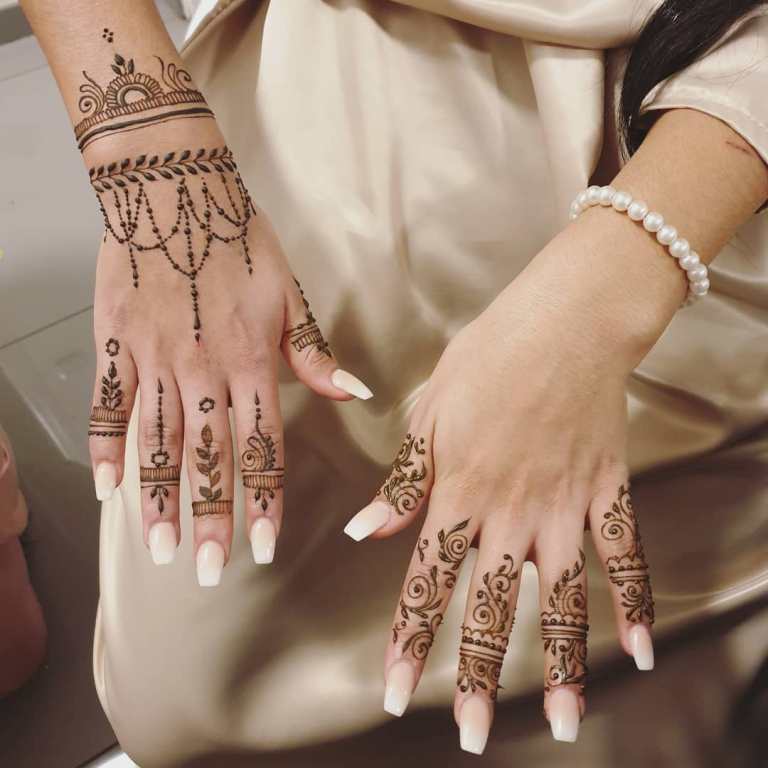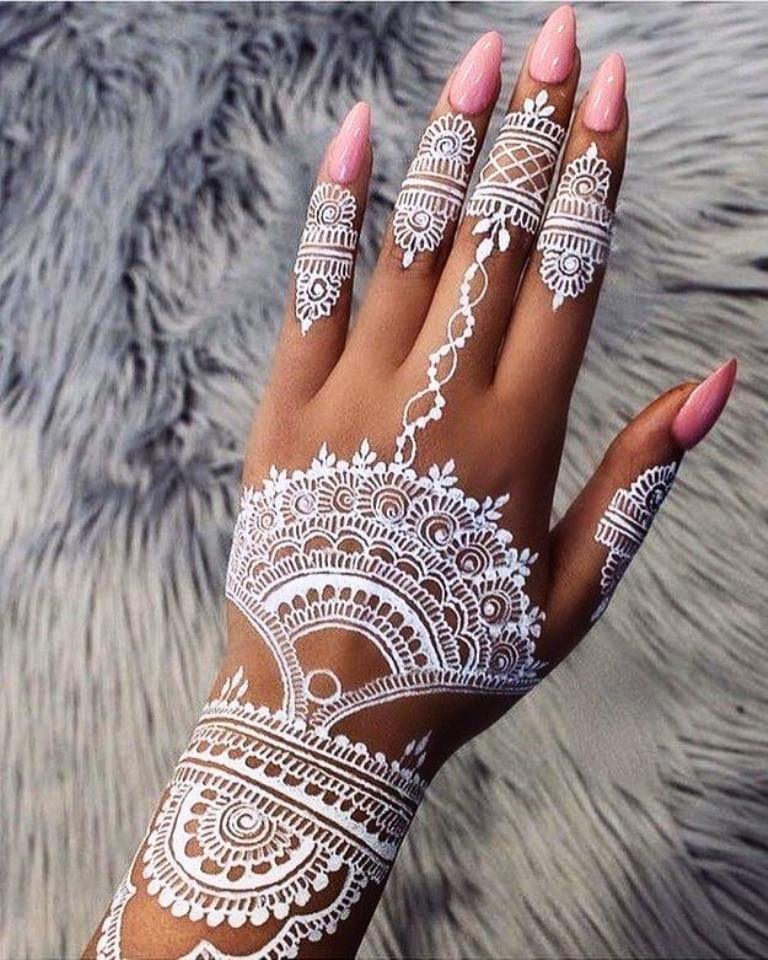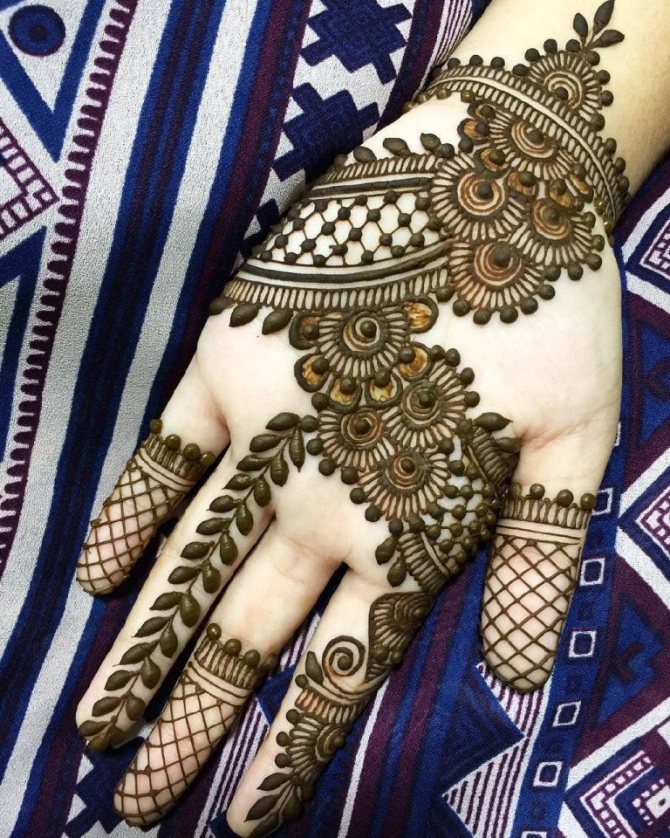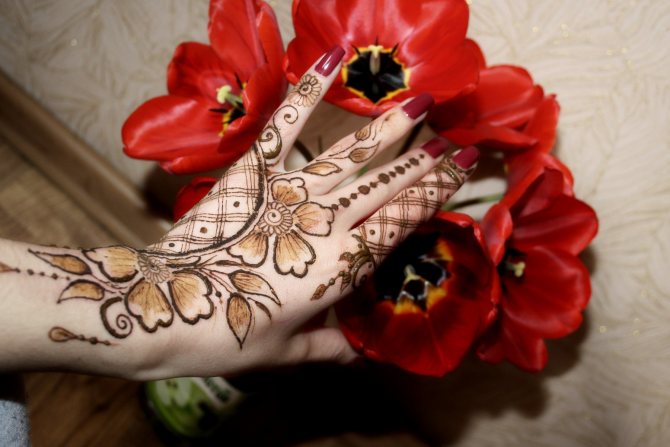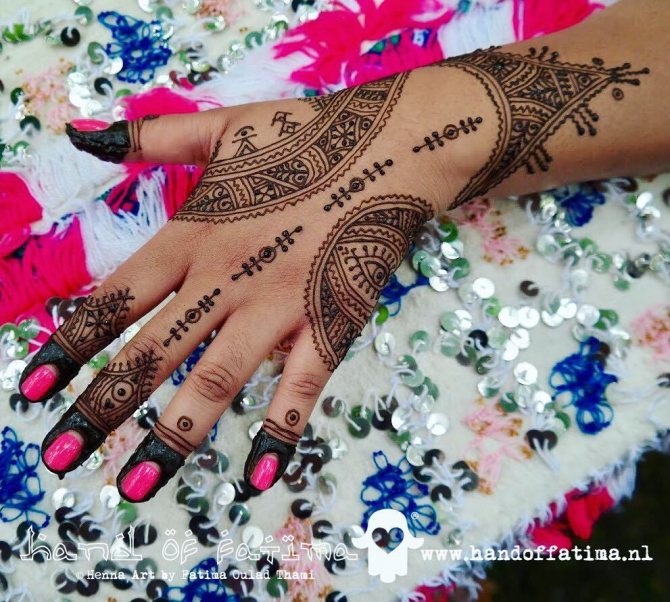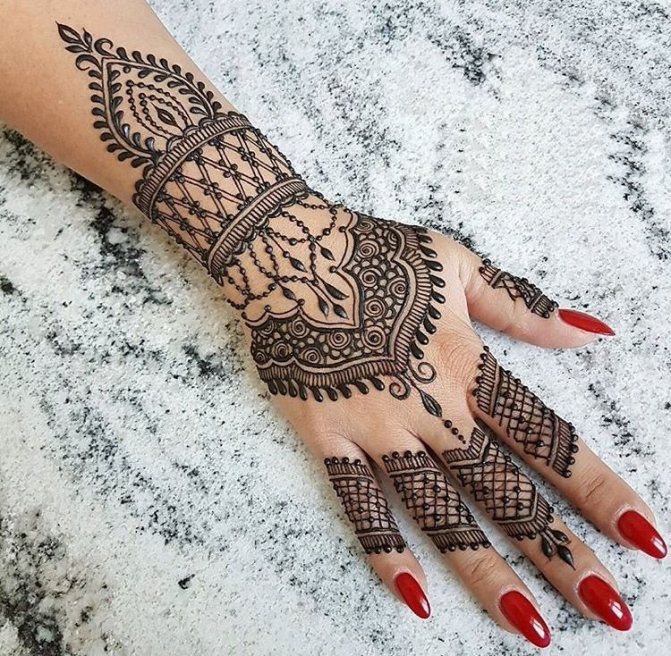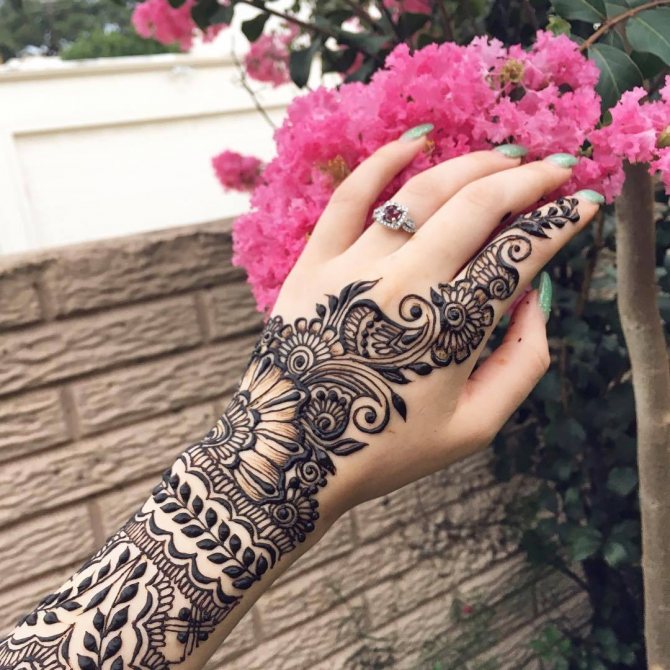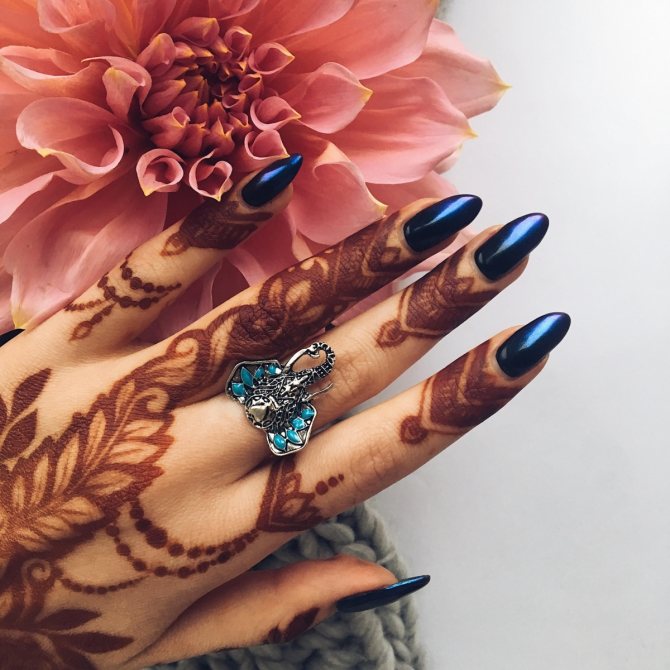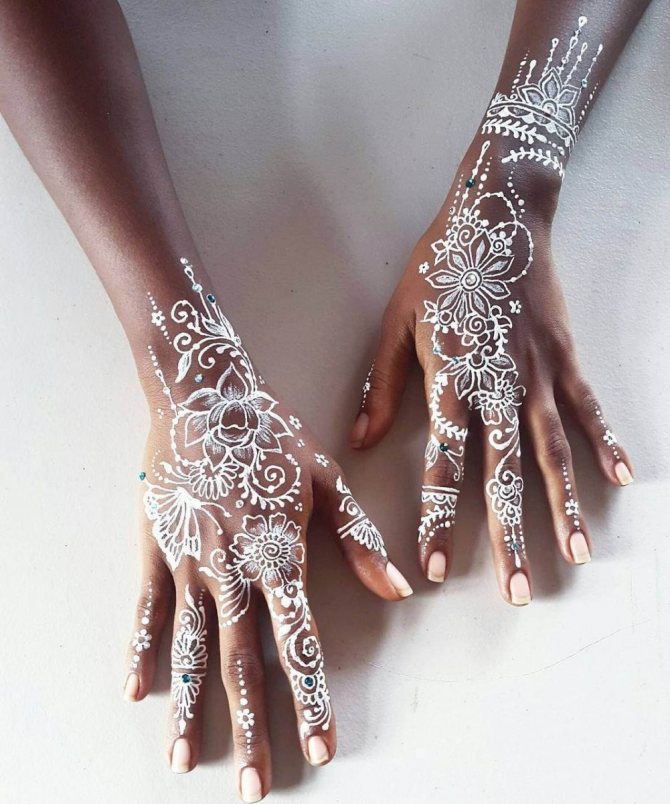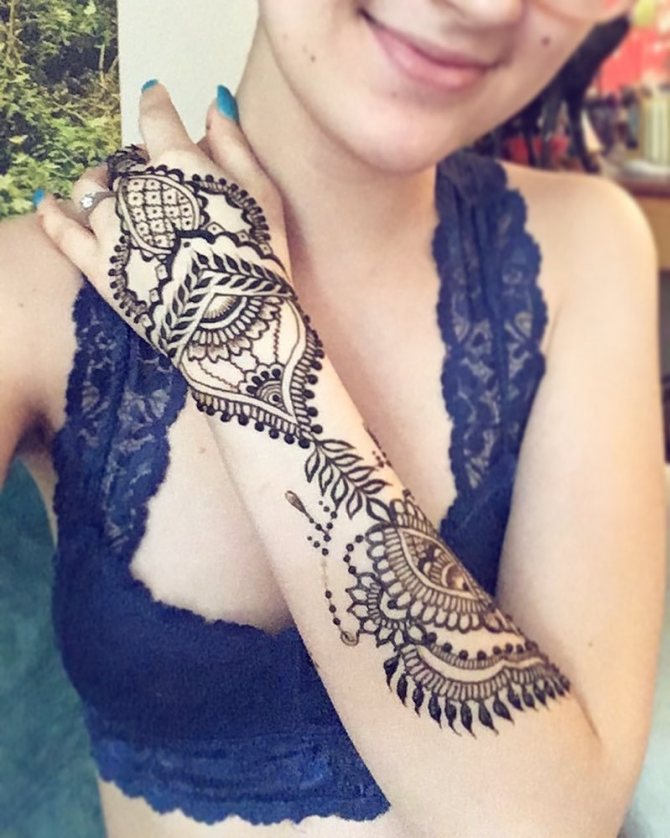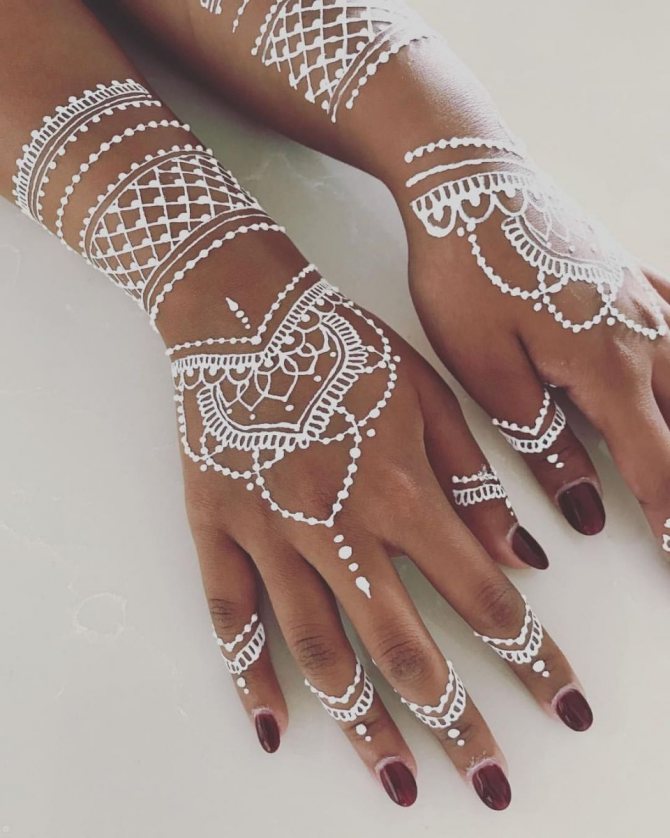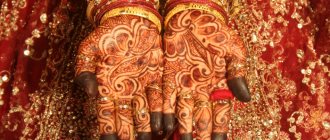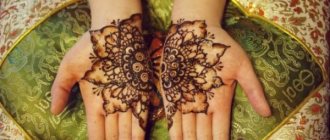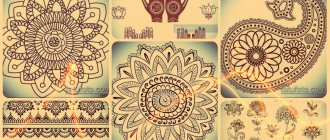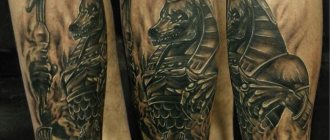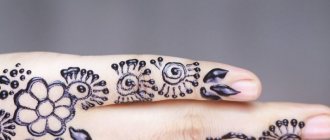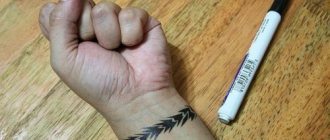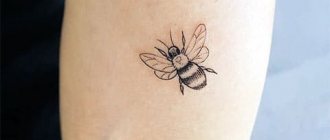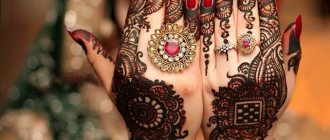What is mehendi on the hand for?
Historically, it was believed that mehendi lines on the fingers, wrists and the back of the hand had mystical powers and were a magical protection for the woman who wore them. Such pattern was endowed with the ability to attract good luck, ward off evil spirits and hostile enchantments.
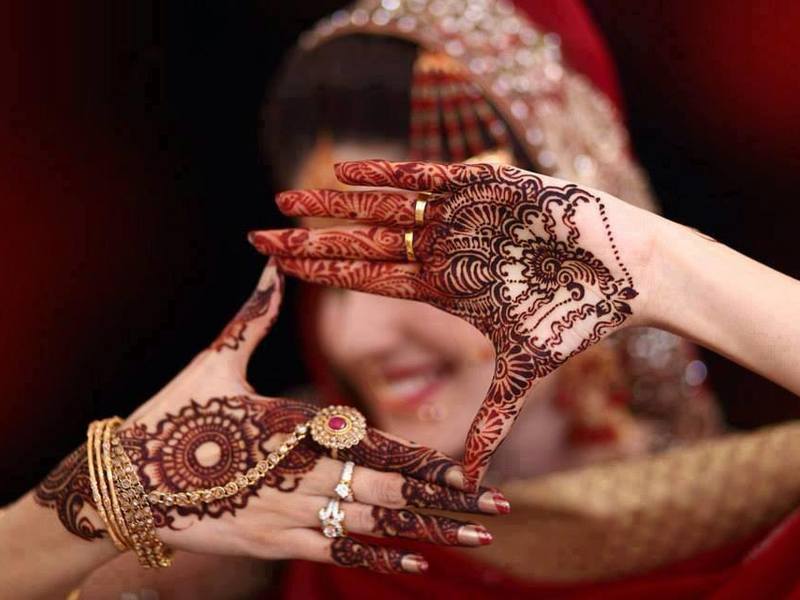
Since ancient times, mehendi was applied on the hands and feet of brides in India and Arab countries.
Today, in Russia and European countries beautiful mehendi drawings on hands are perceived differently. They are no longer invested with mystical connotations. Here are the main reasons to make a henna drawing for a modern girl:
- The desire to emphasize the beauty and elegance of the shape of the hands.
- The desire to give an exotic touch to the image.
- The desire to attract attention.
![]()
![]()
A certain meaning may be invested in the drawing, but in many cases, the bearer of the drawing (and her close friends) interpret its meaning not as prescribed by the classical canons of art.
The difference in the interpretation of a particular mehendi pattern on the hand can put the wearer in an uncomfortable position. Therefore it is necessary to be responsible for the choice of each pattern.
Tattoos for girls henna - drawings on the arm of white, black, colored henna. Photo
Natural henna - reddish color, on the skin it darkens, becoming brown. Such henna is the most resistant, it allows you to perform almost any conceived pattern of this type of tattoo.
To get a black henna, they add a natural black dye.
Drawings made with black henna on the hand are more suitable for dark-skinned people. For light-skinned people, henna of any color is suitable. Colored henna is made by adding different dyes. In this case, the time of preservation of the pattern is reduced.
Exquisite and solemn look drawings of white henna - they are applied for a short time, on special occasions (such as brides for a wedding).
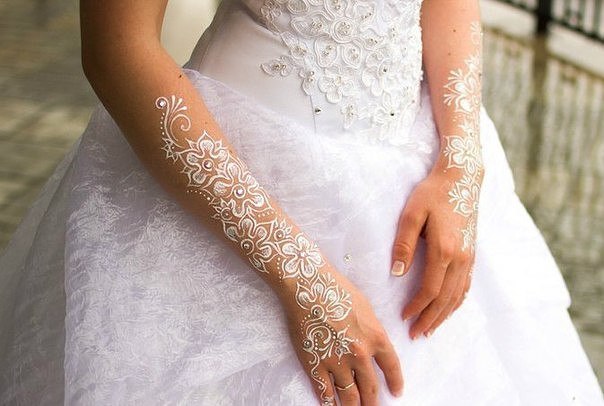

Charming drawings of white henna
Drawings on the hands
The outer and back of the hand is the most popular painting area for women in the East. Traditionally, an openwork pattern is decorated on this part of a bride's body on the eve of an Indian wedding. It is believed that this ritual is a guarantee of a happy and long-lasting marriage.
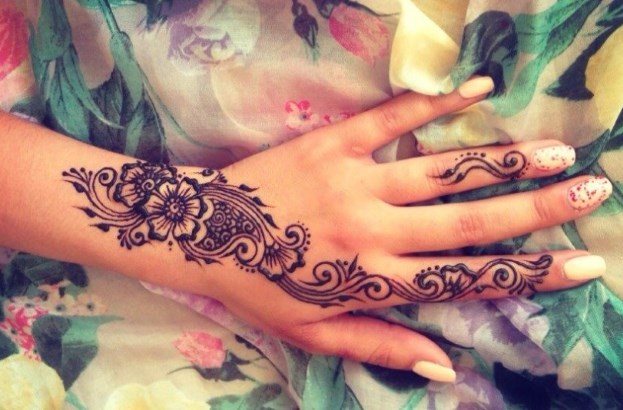

Hand henna painting
In Europe, girls choose such drawings for their tenderness and grace. Thin, smooth lines and curls look best on brushes. Large images will be inappropriate here.
Drawings on the whole hand
It is an option that catches the eye, immediately attracts the attention of others. Especially if the mehendi is made on the entire outer part of the hand (the so-called "sleeve").
More often, the back of the hand, from the wrist to the elbow, is decorated.
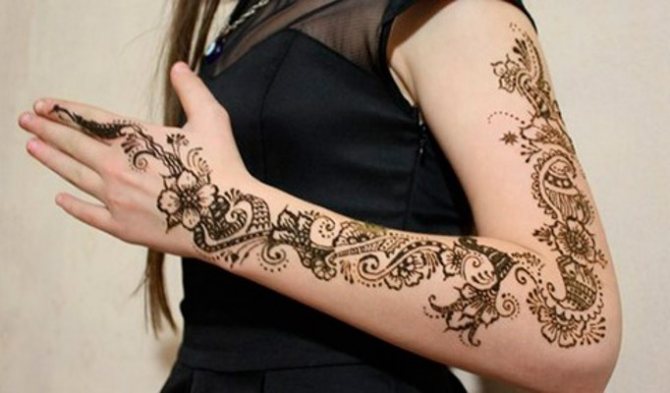

Full arm mehendi
They draw both fancy ornaments and various symbols and plant motifs. In recent years, it has become popular to paint on the back of the hand. (from wrist to elbow).
Pictures on fingers
On the fingers or finger, as a rule, pass drawings made on the hand. Such an image elongates the hand, making it more refined. They are performed in the oriental style - subtle curls, small geometric shapes.
Possible options for decorating fingers and without drawings on the brush.
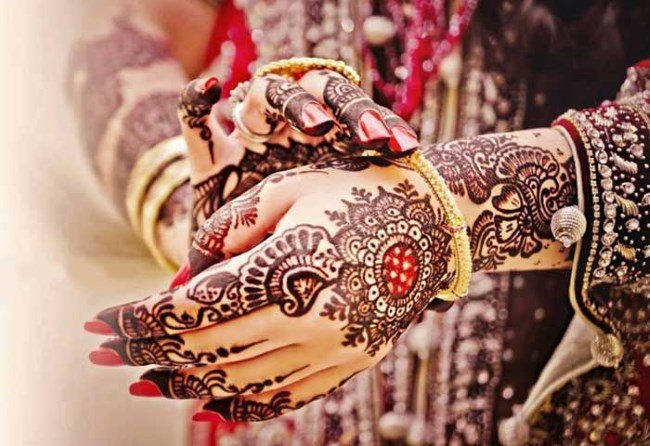

Painting henna on the fingers
They use various small symbolic signs to express their understanding of the world, their relationship to a loved one, their hopes, dreams, etc. Or simply to to emphasize their unconventionality, to draw attention to the beautiful long fingers, well-groomed hands.
What is better: mehendi or a full-fledged tattoo?
A person who is not familiar with the oriental culture can easily confuse mehendi on the hand with the ordinary tattoos, because both types of design can't be washed off by water, remains on the skin for a long time and can carry a certain semantic meaning. But in fact there are more differences in these techniques than similar moments:
- The tattoo is applied using needles that drive the dye deep into the skin. This is a dangerous process, after which it takes quite a long time to fully heal. A henna drawing does not traumatize the skin. Therefore, mehendi is also called biotattooing.
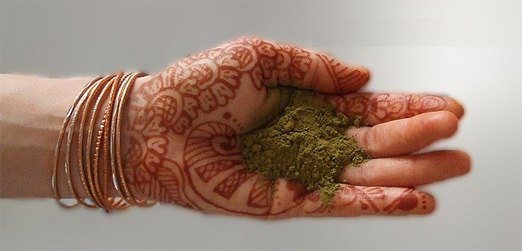

The vitamins and trace elements contained in the paint have a strengthening effect.
- The application of classic tattoos is a painful and lengthy process. Mistakes of the master at any stage can be costly: infection of the skin, bruising due to damaged capillaries, swelling - frequent satellites tattoo. Biotattooing is absolutely painless and has practically no side effects.
- The conventional tattoo creates images that last for decades. If the pattern gets boring, it is very difficult to get rid of it. The mehendi pattern on the wrists or other parts of the hands will completely disappear in 3-4 weeks. This is not always convenient, because it can be a pity to part with the decoration you like. But there is no risk that the image will get bored or go out of style.
It is not quite correct to compare classic tattoos and mehendi. They have different ways of application, purpose and place in world culture. In the future, a henna drawing can become the basis for a future tattoo. Classic tattoos are more extreme and require a much more considered approach.
![]()
![]()
At the expense of less durability mehendi on the hand for beginners is a good way to test: whether you need a tattoo at all.
What you need to know before you pee
Today, girls who have a tattoo are considered stylish and fashionable, they are in trend and in honor among their friends. But making an ornament that will grow up and age with you is reckless. After all, over the years, the tone of the skin changes, losing its elasticity and the once beautiful picture will turn into a net incomprehensible and blurred. But do not get upset, to keep up with your bold friends, you can do a temporary henna tattoo on the hand in the form of an inscription. Such an image will last up to 1 month and will gradually disappear. It can be updated, changed, supplemented without pain or risk to health. In the photo, such a pattern looks like a real one, made with a needle.
When choosing a variant of the pattern, remember that it will be drawn with a thick paste, so it is better to be guided by the following tips:
- The font should be simple without unnecessary squiggles, otherwise the phrase will be difficult to read;
- the letter is medium-sized, as the thickness of the brush or syringe with which the paint will be applied is much wider than the needle for tattooing;
- mehendi loses color intensity in constant contact with water and from friction, so make it in a place where it will be least exposed to these negative factors.
Any body image has to have a meaning. Especially this applies to henna tattoos on the hands or body with words, here it is important to read the translation and know what your phrase is about. Do not just choose by the photo, you have to go deeper into the subject.
The style of the design depends on your personal preferences, some prefer elegant capitals, and some prefer a simple print. Images with quotes best reveal the essence and inner world of a person, they give people food for thought about his fate, the trials he went through. Often in mehendi they make an inscription with the date of a happy moment in life or the name of a loved one.
With the text you can show your individuality, creative inclinations, because it is not necessary to write conventional phrases, you can create your own text, poem or quote.
Is it safe?
The henna drawings are perceived by many as something quite safe and in principle can not cause any harm to health. Because mehendi on the hands is applied without damaging the skin, there is indeed no risk of infection or capillary injury. But there remains the risk of allergic reactions. You should be wary of the appearance of allergic swelling when applying biotattoos yourself or when using the services of masters of dubious qualification.
The fact is that cheap low-quality mehendi hand dyes often contain not only the natural pigment derived from lavsonia leaves, but also auxiliary substances that are not safe for the skin. These include the artificial dye para-Phenyldiamine (PFDA), as well as other synthetic dyes and base components. They give the drawing a bright color and durability, but can cause severe allergies.


Severe allergic reactions can lead to rough scars that do not disappear for many years.
In order not to suffer from the use of low-quality paints, remember a few safety rules:
- When buying paint, don't chase the cheapness. Study the composition, make sure there are no synthetic ingredients, study customer reviews.
- Before using the paint (even if you are absolutely sure of its quality), do an allergy safety test. Apply some paint to the back of your hand. If in 15-30 minutes there was no itching and redness, you are not allergic to the components of the paint.
- Do not use the services of masters, whose professionalism you doubt: street painters, masters working at home who have no qualification.
If you follow these rules, mehendi on the hands is completely safe. Such a procedure is permissible even for pregnant women.
Applying a henna tattoo
The easiest way to apply a picture of henna is to use a special stencil along with an ordinary brush. Such stencils can be made by yourself or purchased on the Internet. If you have an artistic talent - apply henna paste in any way convenient for you. A thin brush, a toothpick or a needle - the choice is yours.
When the design is ready, it's time to fix the tattoo. The tattoo should be covered with eucalyptus oil or mehendi oil. All of these can be bought online. After applying a henna tattoo at home you will feel dry skin tightness. To eliminate the dryness, apply lemon juice to the place of the tattoo. By the way, it also increases the elasticity of the skin.
The meaning of patterns made by henna on the hands
Hands - the place on which the henna drawings are applied most often. This is due to the accessibility of this part of the body to the gaze, the convenience of applying the pattern and the high aesthetics of mehendi patterns on the hands. At the same time each image, be it a white mehendi in the form of abstract ornaments or a bright picture with Hindu symbols has its own meaning.
In interpreting the picture, every moment is important: where the image is located, what size it is, left or right hand. And, of course, it is important what exactly is depicted on the skin. Let's look at the meaning of mehendi on the hands on the example of the most common symbols of this oriental art.
Mehendi on the Hand
The hand on the back of the hand is the most commonly decorated. These can be as simple as easy mehendi on the hand, which is easy for a beginner to draw, as well as complex patterns with many lines. Here are the most common drawings applied in this area:
- Floral mehendi on the hand: a rose or several small flowers with many petals. This pattern symbolizes femininity, passion, love, mental and bodily beauty.
- The feather depicted in the technique of mehendi on the hand is a symbol with many meanings. It is applied by people of creative professions: writers, journalists, bloggers. A broken feather is a sad symbol that signifies the collapse of hopes.


Also, the feather can symbolize the lightness of life, willpower, spiritual flight.
- The most striking sacred meaning is mehendi on the hand, depicting a lotus. It is an important symbol in Hinduism, symbolizing purity and religiosity. Today, it is also seen as a sign that attracts good luck.
- The mehendi owl depicted on the hand means wisdom and power.
- An important amulet in the art of mehendi is a dream catcher depicted on the hand. It is believed that such a drawing can ward off nightmares and worldly troubles.
Mehendi plant and flower themes
Lotus Temporary Tattoo
In dealing with the meaning of the lotus, it is necessary to take into account that we are dealing with a symbolic object of Eastern countries. It is necessary to pay attention to the features of this flower, which grows in an aquatic environment and does not receive nourishment from the earth. Traditionally, the lotus is a symbol of purity and total disregard for all earthly temptations. The holy and pure nature of the lotus exists independently of worldly occurrences and is constantly under the protection of the supreme creator of the universe.
A simple drawing on the arm bracelet and a flower on the palm
Large recognizable flower is often chosen for mehendi women of all ages, because this object is considered to be a symbol of fertility, it indicates the high spirituality of the owner, reflects the strong health of the body and is a symbol of eternal life. Ancient people identified the lotus with the female reproductive organs that gave life to the new person. The image of the flower is often accompanied by a being sitting inside, the motif of a deity inside or emerging from the lotus is of religious origin. As a symbol of water, the flower is depicted by Hindus to emphasize the life-giving and inspiring power of the element. Lotuses on the body can remind us of the mother, act as an icon of the cosmos and testify to the unified principle of the structure and development of our world.
lotus on the chest drawings on the palm large pattern on the scapula
Mehendi in the form of a lotus is suitable for innocent and pure of heart girls, as well as those who wish to acquire such properties. Floral tattoos are suitable for brides and expectant mothers. The lotus, the national Indian flower, helps self-realization for those who are in search of the meaning of life and deny materialism. A beautiful lotus flower is believed to attract good luck and quickly make a person successful.
Patterns on the arm a flower on the nuchal side of the palm drawing on the shoulder and neck with sequins
Temporary tattoos with flowers
In general, under the floral images hides the meaning of a new life. The rose is a common variant of the temporary tattoo, it is often a symbol of virginity. The predominance of any flower buds in the drawing indicates an abundance of love and illustrates a new life. Attractive look on a woman's body mehendi - flowers and leaves. The combination of these elements says about a short period of youth, indicates the birth of a new life. Floral and leafy arrangements are a traditional way of reflecting prosperity and abundance.
on the fingers of the hand on the soles of the feet henna patterns on the hands floral patterns on the hand
Mehendi plants
Fruit motifs in the mehendi world are associated with immortality and are often depicted as a symbol of happiness and joy. The presence of grains in the drawing can denote abundance in the home. A cluster of dots-grains is a sign of the seed or the birth of life, the beginning of the path, fertility and human self-awareness. The owners of the liana tattoo wish to show their perseverance, stubbornness and success in various endeavors. Lianas and in general any curly stems on the body ways to draw away from the negative views and talk about the pronounced business qualities of man. Girls choosing grapevine for mehendi want to talk about devotion.
Temporary tattoo on the arm henna tattoo on the forearm rose drawing on the hand
For maximum durability of temporary tattoos it is necessary to take proper care of the skin and use a high-quality, and most importantly safe paint. Mehendi flowers are in high demand among the fair sex, because they bring tenderness and femininity.
How to do mehendi on the arm step by step
To understand the technique of applying biotattoos, let's understand the process of creating a single image of mehendi on the hand step by step. Here, five steps are highlighted:
- Drawing up the design of the drawing. At this stage, the master discusses with the client what and where will be drawn, what colors will be used and what subjects.
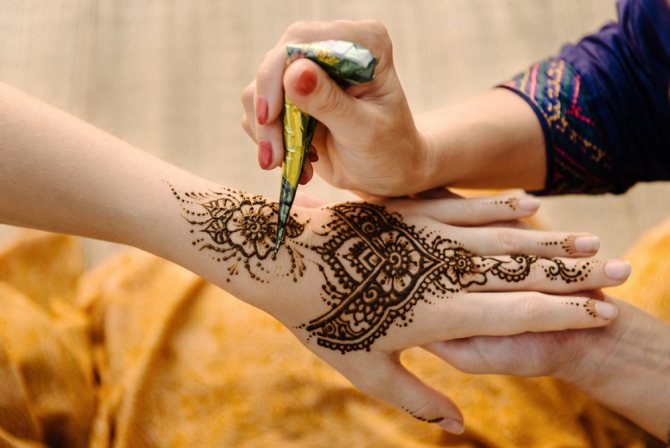

The easiest mehendi on the hands are applied on stencils, more complex patterns are made by the master individually.
- Preparation of the epidermis. At this stage, cosmetics, natural secretions, etc. are washed off the skin. Also the place of the drawing is moistened with lemon juice, so that the acidic environment makes the paint brighter.
- Drawing with a special cone. If any of the strokes are not as planned, the paint is immediately erased with a cotton pad.
- Drying of the paint. Here it is important to wait for 30-40 minutes until the henna paste forms sturdy dry crusts. They are cleaned off with a paper napkin. When applying white mehendi on the hand or multi-colored patterns, several successive dyes will be needed.
Before the coloring paste dries and crumbles, you cannot wash it off with water or soap. The dissolution of the crusts will destroy the color (at best, the pattern will be barely noticeable).
- When the paint dries completely and crumbles from the skin, wipe the drawing with oil or cream. This treatment will get rid of the tightening sensation that remains after the henna.
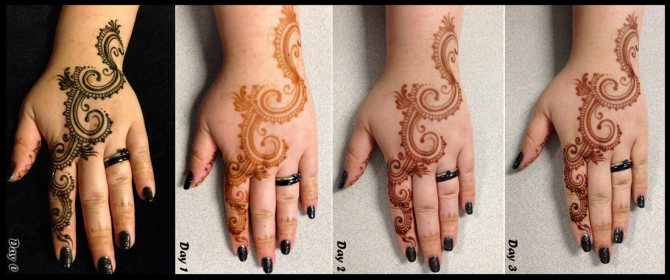

The full color of the biotattoo is achieved within 1-3 days after its application. During this time, it is undesirable to wet it with water, so as not to reduce the "life" of the image.
At home
Today in the cities operates a mass of beauty salons, which provide the service of henna tattooing. But few people know that these pictures can be applied without leaving home, because this does not require any special equipment, and the technique of application - quite simple.
To begin with the choice of powder or paste henna. It is better to buy the raw material, which is designed for tattooing. Henna, which is used for dyeing hair, is not suitable for you.
Before applying the tattoo, it is recommended to eliminate the risk of an allergic reaction. To do this, you need to apply a little henna on the inside of your elbow and leave it for a few hours. If no discomfort reactions do not occur - you can safely proceed to the application of henna tattoo at home.
Examples of mehendi on the arm: photo gallery
The master of mehendi draws inspiration from different sources: cultural traditions that have developed over the years, modern findings, forms of nature. As a source of inspiration, we offer you pictures of mehendi drawings on hands. Appreciate the beauty and elegance of these magical patterns!


